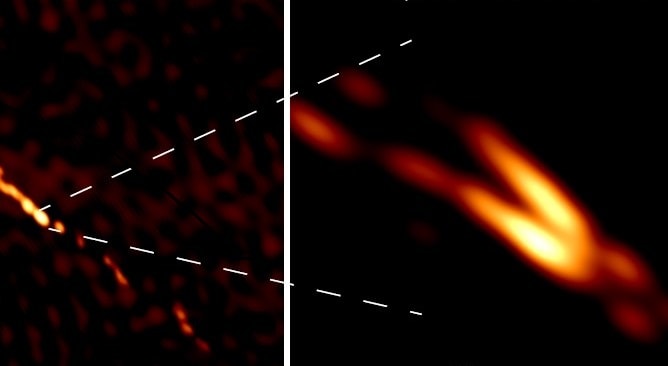
Astronomers have followed up their seminal 2019 observation of the supermassive black hole at the heart of the galaxy Messier 87 (M87) with stunning images of another black hole. This time they have used the Event Horizon Telescope to make high-resolution observations of a jet of plasma emerging from the supermassive black hole in the active galaxy Centaurus A, which lies 12 million light-years from Earth in the constellation of Centaurus.
The observations, documented in Nature Astronomy, build upon information astronomers gathered from the glowing ring that represented the matter around M87’s supermassive black hole, which was our first direct glimpse of such an area of space. The new findings reveal that matter around black holes seem to behave similarly over a range of masses.
“They all seem to follow simple symbiotic relationships between the matter that is flowing in via accretion and the matter that is flowing out as jets” says Michael Janssen from the Max Planck Institute for Radio Astronomy in Bonn, Germany, who is lead author on the study. “These relationships hold for all ranges of black hole masses that we have studied so far.”
Black holes all seem to follow simple symbiotic relationships between the matter flowing in via accretion and matter flowing out as jets.
Michael Janssen, Max Planck Institute for Radio Astronomy
Centaurus A’s supermassive black hole has a mass of 55 million times that of the Sun, placing it between M87’s black hole (6.5 billion solar masses ) and our Milky Way’s black hole Sagittarius A* (2.6 million solar masses). The results show that the behaviour of matter observed around M87 is also present in smaller supermassive black holes, such as our galaxy’s own.
As the fifth brightest galaxy in the sky and the closest radio galaxy to Earth, Centaurus A has been widely studied, as have the jets that extend outwards from its central region. But astronomers did not have much high-resolution data about this source. “The EHT was able to see Centaurus A in a completely new light, at a 10 times higher observing frequency and 16 sharper resolution than that of previous studies.”
The ETH team examined the central region of this galaxy and its black hole using the same very-long-baseline interferometry (VLBI) techniques that were also used to capture the image of M87’s supermassive black hole. This improved resolution has let the team visualise the jets produced by the active galaxy as a hollow “bi-cone” with bright edges.
“The strong edge brightening of the jet was a surprise,” admits Janssen. “We have seen edge brightening before in other jets but never this extreme. We are still struggling to understand this with our theoretical jet models.”
The properties and overall geometry of the plasma jets at Centaurus A look very much like those found in the jets launched by M87 and its titanic black hole — as well as those emitted by much tinier stellar-mass black holes. Armed with details of these jets, astronomers can tell how a black hole does or does not gobble up surrounding matter.
“The matter swirling around black holes, feeding them by forming an accretion disk, is also fuelling jets,” explains Janssen. “Not all particles in the direct vicinity of a black hole are devoured. Some escape and are hurled into space, forming the jets that we see in sources like Centaurus A.”
Learning that black holes of such widely varying masses “eat” in similar ways could help researchers search the Universe for other, more elusive black holes, particularly those with intermediate masses. But his team’s next target is something much closer to home: Sgr A* at the centre of our galaxy. “Stay tuned for that,” Jansseen says.
